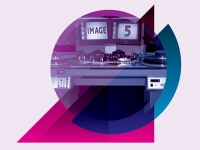Are old hands better than young Turks?
George Foster thinks that there’s something to be said for having a few grey hairs when it comes to devising a Great Idea for a client
A lot has changed since I started work in London’s Charlotte Street. In those days, press ads were sent out to a studio overnight and came back with black-and-white positionals smelling of Cow Gum; rough cuts of commercials seen for the first time on a rattling Steenbeck, with a scene ’dissolve’ to be inserted where indicated by chinagraph marks on the film; and the height of technology – a Magic Marker animatic.
But why the trip down memory lane? Well, I keep being reminded there is something that having been around for a while gives you, and that something is in demand right now. Some call it instant editing – the ability to take a bunch of ideas and be able to spot the good one out of the also-rans.
Others file this under mentoring: someone who can coax and tease a ’not bad’ idea into a ’Blimey, that’s great, where did that come from?’ solution. Plain old leadership is another term for it – leading by example, and helping a bunch of creatives (and account people, too) to bring out the best in themselves and the consultancy. Another current term for it seems to be ’gravitas’.
Look at this job description for a senior digital role in a consultancy, and that word crops up: ’Must be able to lead from the front… mentor creative department… ability to present at a senior level… we need someone with gravitas.’ Suddenly, it appears that having a few grey hairs can be a positive advantage once more, in an industry where this was a no-no a few years back, when creatives were only deemed fit enough to be working on the sexy accounts if they were fresh out of college – or just out of school.
Not for nothing were creative departments referred to as playpens. And from those very playpens usually come left field, finger on the pulse, in touch with the market, award-winning wild and wacky executions – and, incidentally, the raison d’être of any consultancy, the Great Idea for the client.
So style often wins over substance, and that’s okay for a bit, but after a while you end up looking for another style-over-substance idea to replace it. Then the tide turns, those old axioms come tumbling back. A consultancy realises it would be far simpler to go for something that’s got an original thought to it – something campaignable. And who knows more about campaignable ideas than those who were around in the 1970s and 1980s when Charles Saatchi and David Abbott were banging on about needing that in your work every day?
Some of those people, mentored by the great consultancy heads of the time, are still around. What’s more, they haven’t forgotten how to do it. Now those senior people have a real USP. They were there when the heady days of advertising and design called for great ideas and consultancies and clients were prepared to back their creatives – I probably don’t need to remind you that some of the best campaigns were only progressed due to the sheer intransigence and belief in their product of the people selling them.
They know how to get the most out of a campaign because a lot of them have done it for so long it has become second nature. They, above all others, know when something’s a Great Idea.
That’s not to decry what the younger teams are doing these days though. But digital creatives tend to work in silos. Plugged into their iTunes or Internet radio, staring at the screen, they are hugely aware of what is going on in the world, almost overloaded with it, but they somehow find it difficult to communicate it.
They sometimes need a kickstart to get those headfuls of ideas off their Macs and into a presentation that will sell to the client and, of course, the consumer. People who were working before the digital age have something that’s still worth tapping into. They have seen it and done it and got the T-shirt. And they continue to do so when they are given the chance. If you agree there’s a need for people with those skills, I think I can point you in the direction of one or two.
George Foster is founder of virtual digital consultancy Gravitas London

Glossary of terms
Steenbeck – the definitive desktop editing machine for film
Animatic – a roughly animated presentation comprising key frames put together with a rough soundtrack for a client or focus group. Often presented on a U-matic tape…
U-matic tape – according to Wikipedia, a videocassette format, among the first to contain the videotape inside a cassette, as opposed to the various open-reel formats of the time
George Foster is founder of virtual digital consultancy Gravitas London





I fully agree with this article.
We are in an era where clients are looking for more ‘bang for their buck’ so the ideas have to really sharp.
We have had a few students doing work experience with us over the past 12 months and their lack of ideas is really astounding. It appears that they are taught only the technical competence side of the industry rather than the ideas side and very few of them seem to know what a pen and a sketch pad are.
I think this is the era for us elder designers to show the young guns a thing or two about how the creative industry should be.
Many thanks Philip. The ethos has been getting some good comments. Anyone who can bang the drum for the ‘mature’ workforce is most welcome!